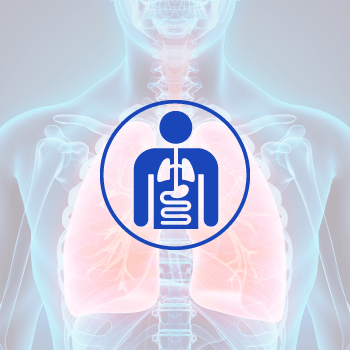BARIATRIC SURGERY PROCEDURES
Bariatric Surgery
Bariatric surgery, also called “weight loss surgery,” is a type of surgical procedure that is meant to help obese people lose weight.
Bariatric surgical techniques work by altering your digestive system — typically your stomach, but sometimes also your small intestine — to limit the number of calories you can intake and absorb. They can also suppress hunger signals sent from your digestive system to your brain.
Many metabolic illnesses, such as diabetes and fatty liver disease, are linked to obesity; these procedures can help cure and prevent them.
Bariatric surgery has been proven to be the only long-term solution to obesity.
Sleeve Gastrectomy
The Laparoscopic Sleeve Gastrectomy, often called the “gastric sleeve”, is the most commonly performed bariatric surgery. Approximately 80% of your stomach is removed during a gastrectomy, leaving behind a much smaller, tubular portion that resembles a sleeve.
The gastric sleeve is a relatively simple, safe, and low-risk procedure that is performed on the majority of patients.
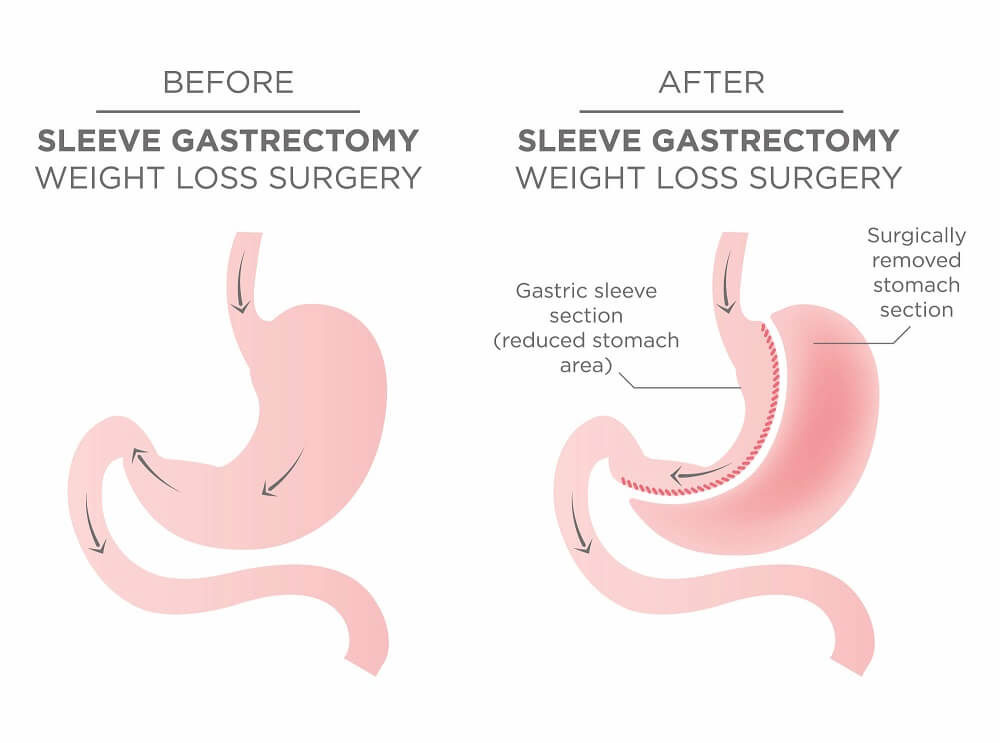
- During the procedure
- After the procedure
- Benefits & Results
Some sleeve gastrectomies are performed with conventionally large (open) abdominal incisions. However, a laparoscopic sleeve gastrectomy involves inserting small tools through numerous tiny incisions in the upper abdomen.
When performing a sleeve gastrectomy, the surgeon removes the larger, curved portion of the stomach and stitches the stomach vertically to make a narrow sleeve.
Normally the surgery lasts one to two hours. You awaken in a recovery room post-surgery, where medical staff monitor you for any complications.
Following a sleeve gastrectomy, your diet should consist primarily of sugar-free, noncarbonated liquids for the first seven days, followed by pureed foods for three weeks, and then regular foods around four weeks after the procedure.
In the first three to six months after a sleeve gastrectomy, you may notice the following changes as your body adjusts to the rapid weight loss:
- Body pains
- Experiencing fatigue as though you have the flu
- Feeling cold
- Dry skin
- Mood shifts
Sleeve gastrectomy can help you lose weight permanently. The amount of weight you lose is determined by your changes in lifestyle. Within two years, you could reduce 60% of your excess weight or even more.
Along with weight loss, sleeve gastrectomy may cure or resolve conditions associated with obesity, such as:
- Cardiovascular disease
- High blood pressure
- High cholesterol levels
- Obstructive sleep apnea (OSA)
- Diabetes type 2
- Stroke
- Infertility
Sleeve gastrectomy surgery can enable you to accomplish routine daily activities and improve your quality of life.
Mini Gastric Bypass
The Mini Gastric Bypass (MGB) is a laparoscopic gastric bypass weight loss procedure that is quick, simple, effective, and reversible. Recently, the term was changed to One Anastomosis Gastric Bypass (OAGB). The procedure normally takes less time and requires a shorter hospital stay than a conventional bypass.
According to a number of studies, the Mini Gastric Bypass achieves equivalent or even better long-term weight loss success than the Gastric Sleeve, Roux-en-Y, and Gastric Bypass.
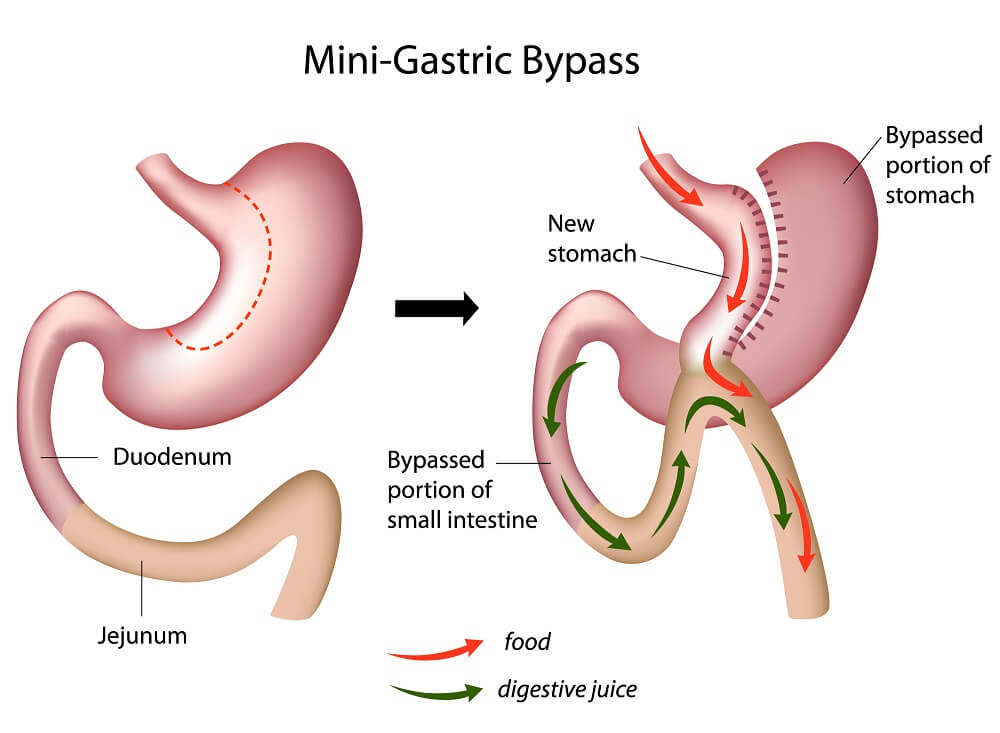
- During the procedure
- After the procedure
- Benefits & Results
- A laparoscopic stapler is used to divide the stomach. Most of the stomach is no longer connected to the esophagus and cannot take food. Your new stomach has a tube-like form and is considerably smaller.
- Two to seven feet of the intestines are bypassed. The remainder of the intestines will be connected to the new stomach by the surgeon.
- Food now enters a tiny, tube-like stomach and then bypasses between 2 and 7 feet of intestines before resuming normal digestion in the remaining intestine.
Typically, you will be required to stay overnight in the clinic. Occasionally, patients are observed for an additional day.
You may experience abdominal pain after surgery, particularly at the incision sites. The length of the typically 5 incision sites is between 5mm and 12mm.
Once you get home, you must adhere to a strict diet. For the first two weeks after surgery, a liquid diet (soft food) is usually recommended. Protein drinks, water, pureed soft meals, and soup are all options. Soft foods are offered after two weeks. After a month, you’ll be able to resume your normal diet. You will, however, be required to follow a new diet that includes more protein, vegetables, and fruit. You have quite a much smaller stomach and no room for junk food (you need to maximize nutrients from every bite you eat).
The mini-gastric bypass, like any other form of surgery, has a risk profile that you should be informed of before proceeding. While complications such as anemia or the need for dietary supplements occur, they are minimal, with 90-95% of patients experiencing no complications.
In contrast to procedures like the gastric band, this one doesn’t need frequent adjustments to keep it functional.
- Limits the amount of food consumed as well as the number of calories absorbed
- Increases intestine GLP1 production, which enhances insulin release and is more effective for curing diabetes
- Eating meat and bread is a little easier
- Slightly more effective than sleeve in terms of weight loss
- Probability of reversal
Gastric Bypass Surgery
Gastric bypass, commonly known as Roux-en-Y gastric bypass, is a form of weight-loss surgery involving the creation of a small pouch from the stomach and connects directly of the pouch to the small intestine. After gastric bypass, food will enter this small stomach pouch and then enter the small intestine directly, bypassing most of the stomach and the first portion of the small intestine.
Gastric bypass surgery is performed when diet and exercise have failed or when you have serious health concerns as a result of your weight.
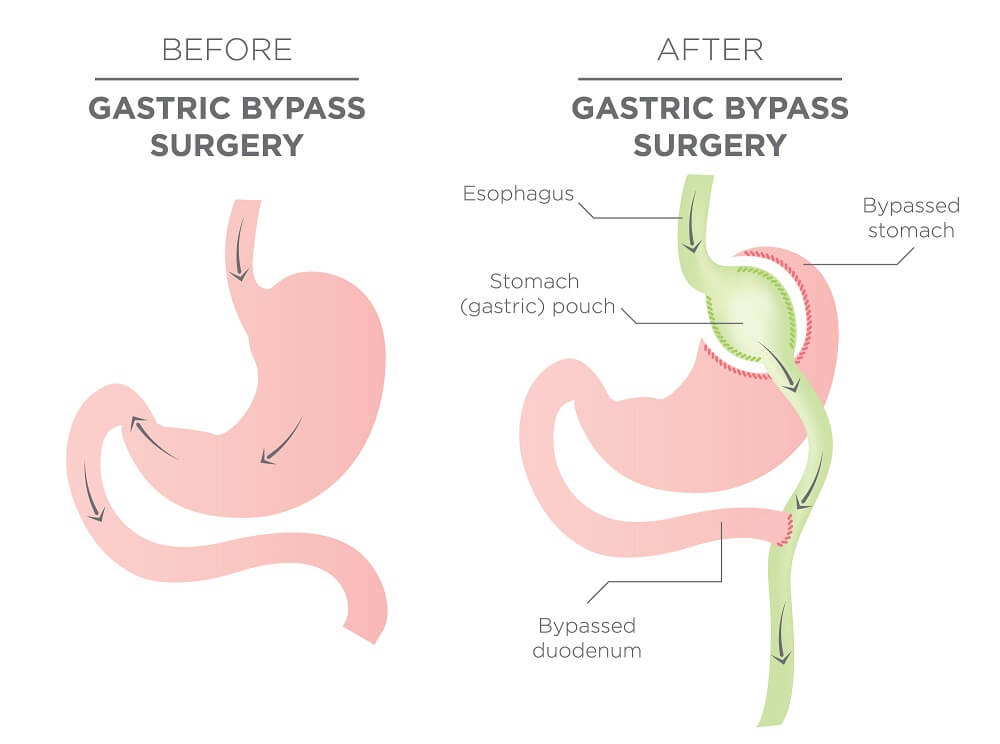
- During the procedure
- After the procedure
- Benefits & Results
Some procedures are performed through conventionally large (open) abdominal incisions. However, most are done laparoscopically, involving multiple small abdominal incisions through which instruments are inserted.
The stomach is first divided into a smaller upper section (pouch) approximately the size of an egg. Most of the stomach is bypassed, and food is no longer stored or digested.
To allow food to pass, the small intestine is divided and connected to the new stomach pouch. The small bowel segment which empties the bypassed or larger stomach is connected to the small bowel about 3-4 feet downstream, resulting in a bowel connection that resembles the letter Y.
The surgery usually takes a few hours. You awaken in a recovery room post-surgery, where medical staff monitors for any complications.
You may consume liquids but no solid food immediately after gastric bypass surgery as your stomach and intestines heal. You’ll then follow a personalized diet plan that progressively shifts you from liquids to pureed foods. Following that, you can eat soft things before moving to firmer foods as your body is able to tolerate them.
You may be subject to several restrictions or limitations on what and how much you can eat and drink. After surgery, your doctor may advise you to take vitamin and mineral supplements, including a multivitamin containing iron, calcium, and vitamin B-12.
Gastric bypass can result in long-term weight loss. The amount of weight you lose depends on the type of surgery you undergo and the changes you adopt to your lifestyle. Within two years, you may be able to lose 70% or more of your excess weight.
- Excellent short-term weight loss (60 to 80 percent excess weight loss)
- Long-lasting outcomes. According to the data, most patients sustain more than 50% of their excess weight loss up to 20 years after surgery
- Excellent resolution of health issues associated with obesity







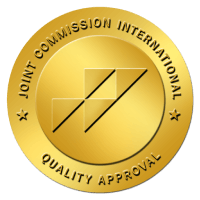
 أنقر هنا
أنقر هنا أنقر هنا
أنقر هنا











